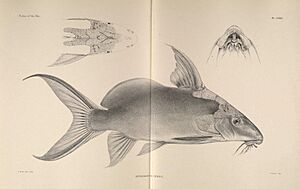Synodontis sorex facts for kids
Quick facts for kids Synodontis sorex |
|
|---|---|
 |
|
| Conservation status | |
| Scientific classification | |
| Genus: |
Synodontis
|
| Species: |
sorex
|
The Synodontis sorex is a type of upside-down catfish. You can find it in many rivers across northern Africa. A German scientist named Albert Günther first described this fish in 1864. He found it in the upper Nile River, near Khartoum in Sudan. The name sorex comes from a Latin word meaning "shrew" or "shrew-mouse". We're not sure why it was chosen, but it might be because of the fish's pointed nose or its long, thin teeth.
Contents
What the Synodontis Sorex Looks Like
Like other Synodontis fish, the S. sorex has a strong, bony head. This head bone goes all the way back to the first spine of its top fin (dorsal fin). Its head also has a special bony part called a humeral process. The shape and size of this part help scientists tell different Synodontis species apart. For the S. sorex, this bony part is rough and a bit longer than it is wide. It has a rounded or blunt end.
Its Whiskers and Fins
This fish has three pairs of barbels, which are like whiskers. One pair is on its upper jaw (maxillary barbels). The other two pairs are on its lower jaw (mandibular barbels). The upper whiskers are straight and have a wide base. They are about two-fifths to one-half the length of the fish's head. The outer pair of lower whiskers is about 1.5 to 2 times longer than the inner pair. These whiskers have long, thin branches with smaller branches coming off them.
The front edges of the top fin (dorsal fin) and the side fins (pectoral fins) of Synodontis species are hard spines. In the S. sorex, the top fin's spine is about the same length as its head, or a little shorter or longer. It can be straight or curved. This spine has jagged edges on both the front and back. The rest of the top fin has seven soft, branching rays. The spine of the side fin is shorter than the top fin's spine. It is smooth on the outside edge but jagged on the inside edge.
The S. sorex also has a small, fleshy fin called an adipose fin. This fin is 3 to 5 times longer than it is deep. Its anal fin (near the tail) has four unbranched rays and eight branched rays. This fin comes to a sharp point. The tail fin (caudal fin) is deeply split, like a fork. The upper part of the tail is longer than the lower part and often ends in a thin string-like part.
Its Teeth
All Synodontis fish have a special pad of teeth on the very front of their upper jaw. This is called a premaxillary toothpad. It has several rows of short, chisel-shaped teeth. The S. sorex has two or three rows of these teeth, but not many of them. On its lower jaw, the teeth are attached to flexible, stalk-like parts. These teeth are often described as "s-shaped" or "hooked." The number of teeth on the lower jaw helps tell different species apart. The S. sorex usually has about 6 to 8 teeth on its lower jaw.
Its Color and Size
The Synodontis sorex is grey on its back and sides. Its belly is white. Its fins are light-colored. There is a clear dark spot on its top fin near the base. Each part of its tail fin has a dark band. The whiskers are white.
This fish can grow up to about 36 centimeters (about 14 inches) long. Generally, female Synodontis fish tend to be a bit larger than males of the same age.
Habitat and Reproduction
You can find the Synodontis sorex in many places, from Senegal in West Africa all the way to Ethiopia in East Africa. People sometimes catch this fish for food.
Reproduction
Scientists don't know much about how most Synodontis species reproduce. We know that females can carry many eggs. It's likely that they lay their eggs during the rainy season, which is usually between July and October. During this time, pairs of fish might swim together when they lay their eggs. Young fish grow very quickly in their first year. After that, their growth slows down as they get older.


